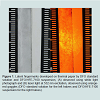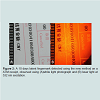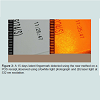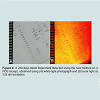Journal of Forensic Investigation
Download PDF
Research Article
*Address for Correspondence: Yaping Luo, Department of Forensic Science, Chinese People’s Public Security University, Beijing 100038, China, Tel:+86 13501265813; Fax: +86 010-83903380; E-mail: lyp6698@163.com
Citation: Mao N, Zhao Y, Luo Y. A New DFO Method for Developing Latent Fingermarks on Thermal Paper. J Forensic Investigation. 2014;2(4): 3.
Copyright © 2014 Mao N, et al. This is an open access article distributed under the Creative Commons Attribution License, which permits unrestricted use,distribution, and reproduction in any medium, provided the original work is properly cited.
Journal of Forensic Investigation | ISSN: 2330-0396 | Volume: 2, Issue: 4
Submission: 29 September, 2014| Accepted: 12 November, 2014 | Published: 14 November, 2014
A New DFO Method for Developing Latent Fingermarks on Thermal Paper
Naize Mao, Yabin Zhao and Yaping Luo*
- Department of Forensic Science, Chinese People’s Public Security University, Beijing 100038, China
*Address for Correspondence: Yaping Luo, Department of Forensic Science, Chinese People’s Public Security University, Beijing 100038, China, Tel:+86 13501265813; Fax: +86 010-83903380; E-mail: lyp6698@163.com
Citation: Mao N, Zhao Y, Luo Y. A New DFO Method for Developing Latent Fingermarks on Thermal Paper. J Forensic Investigation. 2014;2(4): 3.
Copyright © 2014 Mao N, et al. This is an open access article distributed under the Creative Commons Attribution License, which permits unrestricted use,distribution, and reproduction in any medium, provided the original work is properly cited.
Journal of Forensic Investigation | ISSN: 2330-0396 | Volume: 2, Issue: 4
Submission: 29 September, 2014| Accepted: 12 November, 2014 | Published: 14 November, 2014
Abstract
A new method for improvement of DFO-treated latent fingermarks on thermal paper will be described in this paper. A DFO powder suspension was prepared using an ultrasonic cleaner to ensure DFO’s maximum solubility. The new method in this paper effectively developed latent fingermarks on a variety of thermal paper substrates and provided more friction ridge details and even better contrast without ink running, damage to documents, or background coloration. Examination and photography should be conducted in the luminescence mode, with excitation at 532 nm and observation with orange-red goggles. In addition, some tests were performed, leading to an optimized working solution and the sensitivity, selectivity and stability of the method were also investigated.Keywords
Latent fingerprint; Thermal paper; DFO; Powder suspensionIntroduction
The compound 1,8-diazafluoren-9-one (DFO) is an amino acid–sensitive reagent that gives a reaction product that is pale purple in color and excellent photoluminescence without any post-treatment. This is particularly relevant to the enhancement of marks on porous surfaces that are ineffective after initial ninhydrin development.DFO was first suggested as a latent fingermark development reagent by Pounds in 1990 [1], and since then, modifications to the original DFO method have been investigated by various research groups in an attempt to stabilise the working solution and improve the fingermark ridge contrast produced by the technique. Masters et al.[2] investigated the usage of DFO and provided a petroleum ether/xylene formulation that used to successfully detect latent fingermarks. In 1993, Hardwick and coworkers [3] modified the original DFO formulation to obtain a solution that is easier to produce and stable for several months. Their suggested formulation, however, is based on the ozonedepleting solvent CFC113. Didierjean’s group [4] proposed anew DFO formulation with HFE7100 as the carrier solvent. The HFE7100 formulation showed more stable at room temperature for several weeks after preparation, with fingermark detection results at least as good as those obtained using a CFC113-based solution. The effectiveness and the reaction mechanism of these improvements were also confirmed by Kent in 1998 [5]. However, treatment with all these DFO solution result in heavy background staining on the thermosensitive side of thermal paper and loss of contrast between developed fingermark ridges and the substrate, due to the need of petroleum ether, hexane or heptane in the working solution.
In responding to this difficulty, recently Schwarz presented a modified version of working solution containing pyrrolidone based on compounds referred to as ‘G3’, to decolorize the blackened paper [6]. Current new methods of detection latent fingermarks on thermal paper include the sequential use of PVP. PVP, a type of non-ionic polymer, that is used to greatest effect on the background decoloration of thermal paper. In 2010, by adding polyvinyl pyrrolidone (PVP) into the solution of ninhydrin, Schwarz achieved very promising results [7]. More recently, the evaluation of one-step DFO/PVP and 5,6-Dimethoxy- 1,2-indandione/PVP to latent fingermarks development on thermal paper has been reported by our group [8,9]. These new techniques results not only in a fluorescent fingermarks appear in sharp lines and high contrast, but also in a significant diminution of the number of development steps. However, we found that these two processes would result in ink running and obscure prints in some items from actual casework.
Herein, the research presented here aimed to further optimise the DFO working solution, to improve the detection and to reduce the complexity required for latent fingermark enhancement on thermal paper. Secondly, the project aimed to exam the performance of the new method on a variety of commonly encountered thermal paper with both fresh fingermark samples and exhibits aged up to 240 days.
Material and Methods
MaterialsDFO was purchased from Beijing FenGe Co., Ltd (Beijing) and HFE-7100 from Novec 3M (USA). Other solvents (AR grade) were purchased from Beijing Chemical Co., Ltd (Beijing) and used without further purification. HFE 7100 (3M Deutschland GmbH, Neuss, Germany).
Preparation of the DFO standard solution: 0.1 g of DFO is fully dissolved in 50 ml ethanol and 50 ml ethyl acetate and 10ml acetic acid are added, this is then mixed thoroughly with 390ml n-hexane.
Treated samples were photographed using a digital camera (Nikon D7000, Japan). KQ-100 ultrasonic cleaner
Fingermark samples
Fingermark samples were impressed by different individuals (6 male and 4 female). The same procedure was followed for each individual to be tested and each individual repeated this 5 times. A total of 250 latent fingermarks were obtained and treated during the course of study. Five-finger natural depletion series were collected and developed after 1 day, 2 days, 4 days, 7 days and up to 15 days. All samples were taken and allowed to cut in halves to compare DFO standard solution (left halves) with the new method (right halves) before treatment.
Optimization of DFO formulation
It was found that polarity of the working solvent has crucial effect on the thermal paper, when subjected to heat or polar organic solvent (e.g using ethanol as a carrier solvent) led to a significant discoloration of the paper substrate, degradation of image quality and ink diffusion through the paper.
We investigated HFE7100 is a weak polar solvent and using HFE-7100 as the carrier solvent for the working solution, the background was not became dark. However, the solubility of DFO in less or non-polar solvents is very low. We finally chose ultrasonic cleaner to prepare a DFO powder suspension to ensure DFO keep a maximum solubility.
Preparation of the DFO suspension: 0.1 g of DFO was mixed with 500 ml HFE-7100 and followed by sonication for 30min.
Fingermark detection protocol
The testing material was passed slowly through the DFO standard solution or DFO/HFE-7100 suspension for 10s. Repeated the processing 2 times, after drying, the halves had been immersed in the DFO standard solution and heated in an oven at 100 for 10 min, the other one processed by DFO/HFE- 7100 suspension and stored in a clean drawer directly. 3 hours later, the samples were then observed in the laser light source with the emission set at excitation wavelength of 532 nm.
Performance on nature samples
Nature samples of different types of thermal papers used in daily lives, such as automatic teller machine (ATM) receipts, point-of-sale register (POS) receipts and supermarket receipts, were collected to determine the new technique is generally applicable to all types of thermal paper.
Results and Discussions
Efficiency of the new methodThe thermosensitive side of the samples turns dark rapidly when immersed in the DFO standard solution and the flow of dyes also case the damage of fingerprints, while the samples immersed in DFO/HFE-7100 suspension with no blacken appears. It seems that there is no great difference between the two halves when the paper is observed with white light. Actually, the darkness is obvious, while the working solution also became darkness after detection. One possibility mechanism is that the portion of the chemical coating on the thermal paper’s was flowed into the solution when react with conventional agents (Figure 1A). After 3 hours 90% of the fingermarks were developed, with the reaction continues more details appear and it will end after about 24 hours. The fingermarks treated with the new method show strong luminescence and have a great quality of ridge details, some of the samples have a faint initial color (Figure 1B).
The fingermarks were stored for 1, 2, 4, 7 and up to 15 days, the new method still have excellent quality of ridge detail and good contrast with the background (Table 1).
The “score” of fingermarks were determined by the quality score of developed marks. The standardised method and grading scheme of scoring fingermarks is proposed by Bandey [10].
Sensitivity and stability of the new method
The nature samples were treated with the new method according to the described procedures. As shown in (Figures 2-4 ), fingermarks on 10 days ATM receipts, 15 days POS register receipts and 240 days supermarket receipts and were successfully developed. The samples neither turn dark like the ones treated in the DFO standard solution nor allows for the possibility of particular inks being dissolved on the thermal paper like the ones treated in the DFO/PVP solution.
Conclusions
The detection of fingermarks on thermal paper poses significant challenges to the forensic scientist.Figure 1: Latent fingermarks developed on thermal paper by DFO standard solution and DFO/HFE-7100 suspension, (A) observed using white light photograph and (B) laser light at 532 nm excitation, observed using orangered goggles (DFO standard solution for the left halves and DFO/HFE-7100 suspension for the right halves).
In this paper, an optimized DFO formulation is presented that provides sharp and clear development of latent fingermarks on thermal paper. Compared with conventional DFO, the new method has better performance to DFO standard solution across various types of thermal papers and ageing conditions.
The experimental results indicated that the new method was more successful in the development of fresh and old fingerprints deposited on thermal paper, even for 240-day-aged fingerprints. The main benefit of using the new method rather than the conventional DFO formulation is that it has more friction ridge details, even better contrast, easier operation and without ink running, damage to documents, or background coloration. Furthermore, the treated marks exhibit strong fluorescence around 532 nm, photography of the prints treated by the new method can therefore be achieved at 532 nm excitation and observed using orange-red goggles.
In a word, the new method is a simpler and more stable technique for the development of fingermarks on thermal paper. This technique establishes a new possibility for the detection of latent fingermarks in forensic science.
Acknowledgements
The authors would like to thank the programs of Beijing Municipal commission of education for the grant provided to support this research.References
- Pounds CA, Griggs R, Mongkolaussavaratana T (1990) The use of 1,8-diazafluoren-9-one (DFO) for the fluorescent detection of latent fingerprints on paper: a preliminary evaluation. J Forensic Sci 35: 169-175.
- Masters NE, Morgan R, Shipp E (1991) DFO, its usage and results. J Forensic Ident 41: 3-10.
- Hardwick SA, Kent T, Sears VG, Winfield P (1993) Improvements tothe formulation of DFO and the effects of heat on the reaction with latent fingerprints. FBI Law Enforcement Bull 19: 65-69.
- Didierjean C, Debart MH, Crispino F (1998) New formulation of DFO in HFE7100. Fingerprint Whorld 24: 163-167.
- Kent T (1998) Manual of Fingerprint Development Techniques, 2nd ed., London: Home Office Scientific Research and Development Branch, White Crescent Press Ltd, Luton.
- Schwarz L, Klenke I (2007) Enhancement of ninhydrin- or DFO-treated latent fingerprints on thermal paper. J Forensic Sci 52: 649-655.
- Schwarz L, Klenke I (2010) Improvement in latent fingerprint detection on thermal paper using a one-step ninhydrin treatment with polyvinylpyrrolidones(PVP). J Forensic Sci 55: 1076-1079.
- Luo YP, Zhao YB, Liu S (2013) Evaluation of DFO/PVP and its application to latent fingermarks development on thermal paper. Forensic Sci Int 229: 75-79.
- Zhao YB, Feng YX, LuoYP (2013) Improvement in Latent Fingermark Detection on Thermal Paper using 5, 6-Dimethoxy-1,2-indandione/PVP. J Forensic Sci Criminol 1: 202.
- Bandey HL, Gibson AP (2006) The powders process, study 2: Evaluation of fingerprint powders on smooth surfaces, Home Office Scientific Development Branch, Publication No. 08/06.






